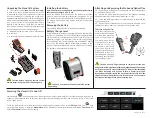
Front Panel Operation
2-101
2.17.1 Digital filters
Digital filter types
The Model 6517A has two types of digital filters: averaging
and advanced. Both types are a simple average of one to 100
reading conversions. The difference between them is the
user-programmable noise “window” of the advanced filter.
The noise window, which is expressed as a percentage of
range (0-100%), allows a faster response time to large signal
step changes (e.g., scanned readings). A reading conversion
outside the plus or minus noise window fills the filter “stack”
immediately.
If the noise does not exceed the selected percentage of range,
the reading is based on an average of reading conversions. In
this case, the advanced filter works the same as the averaging
filter. If the noise does exceed the selected percentage, the
reading is a single reading conversion, and new averaging
starts from this point. The two filter types are compared in
Figure 2-74.
Digital filter modes
An additional filter parameter is the mode, either moving or
repeating. A moving filter is a first-in, first-out stack, where
the newest reading conversion replaces the oldest. An aver-
age of the stacked reading conversions yields a reading.
Therefore, after a selected number of conversions, a moving
filter gives a new reading for every new conversion.
A repeating filter takes a selected number of reading conver-
sions, averages them, and yields a reading. It then flushes its
stack and starts over. This characteristic is useful when scan-
ning channels.
Filter modes are compared in Figure 2-76.
Response time
The various filter parameters have the following effects on
the time needed to display, store, or output a filtered reading:
• Filter type: The time to the first reading is the same for
both types, but thereafter moving mode yields a faster
reading than repeating mode. Also, advanced has a faster
response to changes in the input signal than averaging.
• Number of reading conversions: Speed and accuracy
are tradeoffs.
• Noise window: For the advanced type, a tradeoff of
speed, accuracy, and response to input signal changes.
2.17.2 Median filter
The median filter is used to determine the “middle-most”
reading from a group of readings that are arranged according
to size. For example, assume the following readings:
20V, 1V, 3V
The readings are re-arranged in an ascending order as follows:
1V, 3V, 20V
From the above readings, it can be plainly seen that 3V is the
median (middle-most) reading.
The number of sample readings used for the median calcula-
tion is determined by the selected rank (1 to 5) as follows:
Sample readings = (2
×
R) + 1
where; R is the selected rank (1 to 5)
For example, a rank of 5 will use the last 11 readings to de-
termine the median; (2
×
5) + 1 = 11.
Each new reading replaces the oldest reading, and the medi-
an is then determined from the updated sample of readings.
















































